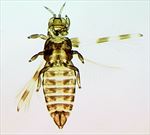
ornatus female
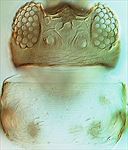
ornatus head & pronotum
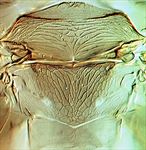
ornatus meso & metanota

latimaculatus_head & pronotum
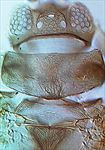
minowai_head & pronotum

minowai_metacurca
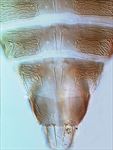
minowai_tergites VI-X
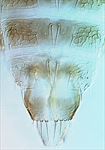
stannardi_tergites V-X

sexmaculatus_head & pronotum
Generic diagnosis
Female macropterous. Head wider than long; ocellar setae pair I present, postocular setae minute or absent; maxillary palps 3-segmented. Antennae 7- to 9-segmented; segment I without paired dorso-apical setae; III and IV with sense-cones forked or simple. Pronotum wider than long, no long posteroangular setae. Mesonotum median pair of setae near middle; anteromedian campaniform sensilla absent. Metanotal sculpture variable; median setal pair behind anterior margin; campaniform sensilla absent. Fore wings fully developed; anterior margin fringe cilia arise ventrally behind wing margin; veinal setae all minute; first vein with wide gap in setal row, second vein with few setae; clavus with four or five veinal and one discal setae; posterior fringe cilia straight; apex of forewing curving without long setae. Prosternal ferna widely divided; basantra membranous and without setae. Mesosternal endofurca with spinula; metasternal endofurca large, U- or lyre-shaped and reaching mesothorax. Tarsi 1-segmented. Tergites without ctenidia or craspeda, with transverse or reticulate striae laterally usually bearing many internal dots or wrinkles; II–VIII median setae longer than distance between their bases; VIII with almost complete comb; IX with only posterior campaniform sensilla present; X median split absent. Sternites without discal setae; sternites III–VII with 3 pairs of posteromarginal setae, II with 2 pairs.
Male similar to female, sternites without pore plates.
Biological data
Species of Dendrothrips breed on leaves, although usually not on newly emerged very young leaves, and many have been recorded from species of Oleaceae (Marullo, 2003).
Distribution data
Only two genera and 10 species of sub-family Dendrothripinae are endemic to the American continent, with all of the other members of the group found widely across the Old World. The species of Dendrothrips are recorded from Europe to Australia, including Africa and Asia. In China, most of the recorded species are from the South, but with one palaearctic species recorded from Beijing.
Nomenclatural data
Dendrothrips Uzel, 1895: 159. Type species Thrips ornatus Jablonowski, by subsequent designation.
This genus comprises 56 species across the Old World (ThripsWiki, 2020), with the following nine species recorded from China:
guttatus Wang, 1993: 254.
homalii Zhang & Tong, 1988: 276.
maltimaculatus Nonaka & Okajima, 1991: 110.
mendax Bhatti, 1971: 353.
minowai Priesner, 1935: 353.
octosparsus Wang, Mound & Tong, 2019: 244.
ornatus (Jablonowski, 1894: 93). (Thrips)
sexmaculatus Bagnall, 1916: 401.
stannardi (Ananthakrishnan, 1958: 216). (Dendrothripiella)
Relationship data
Thripidae sub-family Dendrothripinae: This sub-family comprises 105 species (ThripsWiki, 2020), almost all Old World in origin, and all with the metathoracic furca elongate, extending to the mesothorax. Dendrothrips is one of 12 genera currently recognised in this group (Mound & Tree, 2015). The species of Dendrothrips have the fore wing anteromarginal cilia arising ventrally behind the margin, but in contrast to species in other genera with this character state the wing apex is recurved without a terminal seta. Relationships of this genus are also discussed by Masumoto & Okajima (2017).
References
Marullo R (2003) Host relationships at plant family level in Dendrothrips Uzel (Thysanoptera: Thripidae, Dendrothripinae) with a new Australian species. Australian Journal of Entomology 42: 46–50.
Masumoto M & Okajima S (2017) Studies on Dendrothripinae (Thysanoptera, Thripidae) from Japan, with new records and one new species. Zootaxa 4362: 405-420.
Mound LA & Tree DJ (2016) Genera of the leaf-feeding Dendrothripinae (Thysanoptera, Thripidae), with new species from Australia and Sulawesi, Indonesia. Zootaxa 4109 (5): 569–582.
ThripsWiki (2020) ThripsWiki - providing information on the World's thrips. <http://thrips.info/wiki/Main_Page>